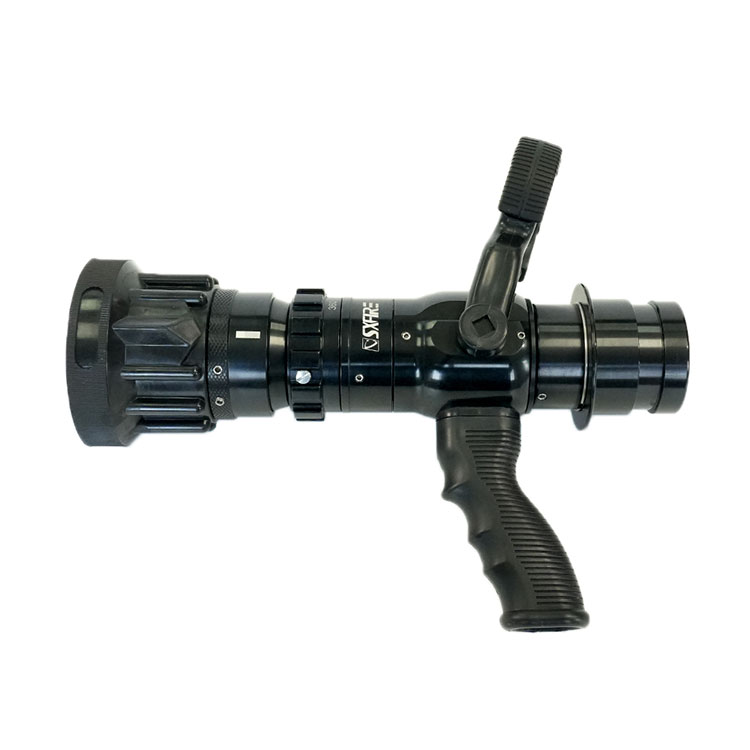Why Is the Fire Nozzle a Critical Tool for Firefighting?
2025-01-07
In any emergency fire situation, every second counts. When a fire breaks out, rapid response and effective firefighting techniques are crucial to save lives and minimize property damage. One of the most essential tools in a firefighter’s arsenal is the fire nozzle. But why is the fire nozzle so critical in firefighting? In this blog, we will explore the function of fire nozzles, their different types, and why they are indispensable in controlling fires efficiently.
What is a Fire Nozzle?
A fire nozzle is a crucial piece of firefighting equipment that attaches to the end of a fire hose. Its primary function is to control the flow, pressure, and pattern of water being discharged to extinguish a fire. Fire nozzles come in a variety of designs, each serving a specific purpose depending on the type of fire being fought, the conditions of the scene, and the equipment being used. By regulating the flow and spray pattern, nozzles allow firefighters to manage the water more effectively, ensuring that it is directed where it’s most needed.
The Importance of Fire Nozzles in Firefighting
1. Control Over Water Flow and Pressure:
One of the main reasons fire nozzles are so essential is because they allow firefighters to control the amount of water being discharged. In a high-pressure situation, adjusting the nozzle can help regulate water flow, preventing wastage and maximizing the water’s effectiveness. For instance, a nozzle with a lower flow rate may be used when a smaller, contained fire is being fought, while a high-flow nozzle is suitable for large-scale fires that require large volumes of water.
2. Versatility in Different Firefighting Situations:
Fire nozzles come in different types to suit various firefighting situations. For example, some nozzles have adjustable spray patterns, allowing firefighters to switch between a fine mist for sensitive areas or a wide, powerful stream for large fires. Nozzles like fog nozzles can create a fine mist of water that cools the air and reduces the spread of fire, making them particularly useful in fighting fires in confined spaces, such as inside buildings.
3. Reducing the Risk of Flashover:
Flashover refers to the rapid spread of fire through the combustion of gases and materials in a confined space. By using the right type of nozzle and water pressure, firefighters can reduce the risk of flashover. For example, a fog nozzle can cool the air and prevent the fire from spreading quickly, while a solid stream nozzle can be used for powerful, direct attacks on the flames.
4. Efficiency in Fire Suppression:
The efficiency of firefighting operations heavily depends on how quickly and effectively firefighters can control the fire. A well-designed fire nozzle enables the rapid application of water to the fire, which is essential in minimizing damage and preventing further spread. With the correct nozzle, firefighters can increase their effectiveness, reduce water consumption, and limit the overall damage caused by the fire.
5. Reducing Firefighter Fatigue:
Firefighting can be physically demanding, especially when using heavy hoses and equipment. The design of fire nozzles plays a role in reducing firefighter fatigue. Some nozzles are specifically engineered to be lightweight or ergonomically designed to reduce strain on firefighters during extended operations. The right nozzle ensures that the firefighter has better control over the water stream, making their job more manageable and improving overall safety.
6. Increasing Firefighting Accuracy:
Different types of fires require different approaches. A fire nozzle allows for increased accuracy when directing water at the source of the fire. Whether it’s a high-rise building or a wildland fire, nozzles enable firefighters to hit precise areas to effectively suppress the fire. The ability to adjust the water flow and pressure ensures that firefighters can tackle the blaze efficiently without wasting valuable resources.
7. Improved Safety for Firefighters:
Firefighting is inherently dangerous, and safety is a top priority. Fire nozzles contribute to the safety of the firefighter in a number of ways. For example, by controlling the flow of water, nozzles prevent excessive water pressure that could cause injury. Furthermore, the nozzle design ensures that water is directed where it’s needed, reducing the risk of firefighters being caught in the direct path of the fire.
Types of Fire Nozzles
There are various types of fire nozzles, each with its unique features designed for specific firefighting tasks:
1. Smooth Bore Nozzle:
A smooth bore nozzle produces a straight, focused stream of water, making it ideal for reaching high areas or for fighting large fires. The nozzle’s lack of obstructions ensures that the water stream maintains its pressure and velocity, which is essential when attacking significant fires.
2. Fog Nozzle:
The fog nozzle creates a fine mist or spray of water, which can be used to cool the surrounding air, reduce smoke inhalation risks, and suppress fires in confined spaces. Fog nozzles are particularly useful when fighting structural fires, as they create a wide coverage area and protect both the firefighter and the fire’s surroundings.
3. Selectable Nozzles:
Selectable nozzles offer versatility by allowing the user to adjust the spray pattern between a solid stream, a wide fog, or a narrow fog. This adaptability makes them effective for a range of fire scenarios, from residential fires to industrial blazes, giving the firefighter greater control over water application.
4. Dual Purpose Nozzles:
These nozzles combine the capabilities of both smooth bore and fog nozzles, allowing the firefighter to switch between a direct stream or a wide spray, depending on the fire’s needs. This flexibility is useful in a variety of environments, as it allows one nozzle to handle multiple situations.
5. Automatic Nozzles:
Automatic nozzles adjust the flow and pressure of water based on the pressure from the hose, making them ideal for situations where the water supply pressure may fluctuate. These nozzles ensure a consistent flow of water, helping to prevent fluctuations that might reduce firefighting effectiveness.
Key Features to Look for in a Fire Nozzle
1. Durability:
Firefighting equipment is subject to intense conditions, including extreme heat, pressure, and water damage. The nozzle must be constructed from durable materials like brass, stainless steel, or aluminum to ensure longevity and resistance to wear and tear.
2. Ease of Use:
Firefighters need to work quickly and efficiently. A well-designed nozzle should be easy to handle, even when wearing heavy protective gear. Features such as ergonomic handles, lightweight design, and simple mechanisms for adjusting water flow or pattern are important for ease of use.
3. Flow Control:
A high-quality fire nozzle should allow for precise control over the water flow. Whether dealing with a small fire or a massive blaze, the ability to adjust the flow can significantly impact the effectiveness of the firefighting efforts.
4. Resistance to Corrosion:
Given that fire nozzles are exposed to water and heat regularly, they must be resistant to corrosion and rust. High-quality fire nozzles are designed with materials that prevent rust and ensure that they perform efficiently over time.
Conclusion: The Power Behind Effective Firefighting
In conclusion, the fire nozzle is a fundamental tool that helps firefighters combat fires effectively and safely. Whether it’s controlling water pressure, improving accuracy, or adapting to different fire types, the nozzle plays a vital role in ensuring that fires are suppressed quickly and efficiently. By investing in high-quality nozzles and ensuring they are used correctly, firefighters can enhance their ability to save lives and minimize damage during critical fire situations. Whether you’re a firefighter or a fire safety enthusiast, understanding the importance of the fire nozzle is key to recognizing its role in keeping our communities safe.



